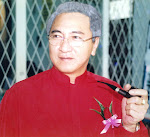"The Chinese always gamble. To them it is not haram (prohibited by religion). Why should we prohibit them? We can't stop them from eating pork because for them it is not “haram," Tun Dr. Mahathir said.
I was having a coffee with my friends at Donggongon this morning and I was informed that there is now a pig farming policy formulated by the Government that pig farming is only allowed at specific locations. In Sabah, the Department of Veterinary has identified Telupid as the location approved for large scale pig farming industry. Telupid is the central part of Sabah.
There are two main reasons given by the Sabah Director of Veterinary, among others, for not allowing pig breeders to carry out their pig farming industry at places other than at Telupid: For religious and health reasons.
This policy has met strong objections from the pig breeders who attended the meeting held on 23rd June 2010 at Kota Kinabalu chaired by the Director himself. According to those local pig farmers who objected to this policy, their livelihood would be greatly affected since they could no longer rear pigs on their own pig farms on their own plot of land nearby.
It is even more disappointing for those small time pig farmers or kampong folks who depend on meat supply as well as getting extra income by rearing pigs at their backyards. They are actually dependent on pork for their own meat supply for consumption. If they are denied of this activity, then the Government is denying their extra income and regular meat supplies for their families.
Pig farming for non-muslims is not “haram”. Why should the Government restrict pig farming at specified locations? The policy may be applicable to a large scale pig farming industry for health (but not for religious reason), but it should not be applied to small scale or backyard industry.
We can’t stop the non-muslims from eating pork nor can we prohibit them from rearing pigs at their backyards on a small scale because it is not “haram” for them.
The Government should formulate a policy for small scale pig farming industry by limiting the number of pigs or piglets to be reared at any one time on their own plot of land, but subject to providing with proper waste disposal system for health reason. Kampung people should be allowed to rear pigs at their own back yards but with limited number of pigs for their own meat supplies to supplement their diet.
The Chinese or Kadazans are very particular about wasting foods. The left-over-foods are too good to be thrown away. Instead, the kampung folks in particular feed their pigs with their left-over-foods, and it is a great way to turn unwanted foods into meat supply. And it is perfectly 'HALAL' for the non-muslims.
With proper waste disposal system in pig farming, health hazard (as being one of the reasons of formulating such a policy) should not be a problem. Again, you can turn the pig wastes into fuel energy for cooking or even providing light energy for your house! The Government should therefore come up with the design of waste disposal system so that small pig farmers can turn the pig waste into energy.








.jpg)


